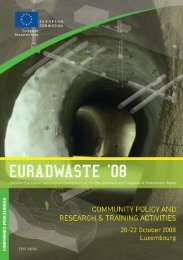EU industrial structure - EU Bookshop - Europa
EU industrial structure - EU Bookshop - Europa
EU industrial structure - EU Bookshop - Europa
Create successful ePaper yourself
Turn your PDF publications into a flip-book with our unique Google optimized e-Paper software.
42<br />
A more detailed picture based on production and not<br />
on value added brings further evidence concerning the<br />
dynamics of <strong>EU</strong> labour productivity growth. As explained<br />
in boxes III.1 and III.2, there is a difference in measuring<br />
labour productivity in terms of value added compared to<br />
measuring productivity in terms of production. Overall<br />
productivity growth, measured as production per hours<br />
worked, for total manufacturing was positive for 2000‑<br />
2010 at 2.3 %. It was higher in 2000‑2005 when it grew<br />
by 2.6 % than in 2006‑10 when the growth rate was 1.9 %.<br />
The latest year for which data are available, 2010, shows<br />
42 See J. Durán, ‘A digression on the notions of production and<br />
value added and the measurement of productivity,’ Economic<br />
Note 2011-01, DG Enterprise and Industry, European Commission.<br />
Chapter III — Drivers of Sector Growth and Competitiveness<br />
available). Including intermediates, however, induce serious measurement errors that have to be kept in mind when<br />
interpreting production per unit of labour input (so‑called productivity ‘based on gross output’). 42<br />
a very strong productivity growth improvement. 43<br />
Significant productivity gains 2006‑10 compared to 2000‑05<br />
in only were achieved in five sectors: beverages, clothing,<br />
leather, computer, electronic and optical products and<br />
other transport equipment. Developments for 2010 are<br />
especially strong in industries producing basic metals,<br />
computer, electronic and optical products, motor vehicles<br />
and machinery n.e.c., cf. Table III.1.<br />
TAbLE III.1: <strong>EU</strong> labour productivity growth 2000-2009 (%). Production per hours worked<br />
code sector 2000‑2010 2000‑2005 2006‑2010 2010<br />
B Mining and quarrying 0.4 1.6 ‑0.8 1.9<br />
c Manufacturing 2.3 2.6 1.9 8.5<br />
c10 Food 2.1 2.9 1.4 2.3<br />
c11 Beverages 3.0 2.9 3.1 2.7<br />
c12 Tobacco ‑0.7 ‑0.7 ‑0.7 ‑4.2<br />
c13 Textiles 0.9 0.9 1.0 8.4<br />
c14 Clothing 1.5 ‑3.4 6.3 10.9<br />
c15 Leather and footwear ‑2.6 ‑5.5 0.4 5.3<br />
c16 Wood and wood products 1.5 2.3 0.7 3.9<br />
c17 Paper 3.0 3.1 2.9 7.3<br />
c18 Printing 1.7 2.8 0.6 5.0<br />
c19 Refined petroleum 2.1 2.6 1.6 3.5<br />
c20 Chemicals 2.9 3.5 2.3 10.8<br />
c21 Pharmaceuticals 5.5 6.0 4.9 8.4<br />
c22 Rubber and plastics 1.1 1.7 0.4 5.8<br />
c23 Non‑metallic mineral products 0.9 2.4 ‑0.6 4.0<br />
c24 Basic metals 2.3 3.3 1.4 18.8<br />
c25 Metal products 0.6 2.0 ‑0.8 7.6<br />
c26<br />
Computer, electronic and<br />
optical<br />
4.7 2.6 6.8 14.3<br />
c27 Electrical equipment 1.8 2.0 1.5 9.7<br />
43 Available at the time of the drafting of the report.<br />
>>><br />
65
















